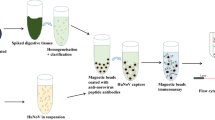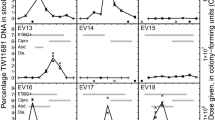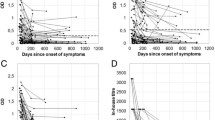Abstract
A rapid and sensitive method for the detection ofShigella dysenteriae type 1 andShigella flexneri serotypes in faeces based on capture of the bacteria with immunomagnetic particles is described. The particles were coated with either of two different monoclonal antibodies specific for the O-antigens ofShigella dysenteriae type 1 andShigella flexneri serotypes. Captured bacteria were detected by an enzyme immunoassay with O-antigen specific rabbit antiserum. The whole assay required 2 to 3 hours to perform and the sensitivity limit was 103 cfu/ml as determined by viable cell counting. One hundred and fifty enterobacteria strains, including 100Shigella strains from a strain collection, and 302 fresh faecal samples were used for the study. AllShigella dysenteriae type 1 andShigella flexneri culture-positive faecal samples were positive in the immunomagnetic assay. In addition 18 of 252 culture-negative faecal samples were positive. The immunomagnetic assay was compared with latex agglutination and indirect immunofluorescence using culture as the reference method. The immunomagnetic assay had a sensitivity of 100%, latex agglutination a sensitivity of 72% with 28% false-negative results, and indirect immunofluorescence a sensitivity of 95%. The immunomagnetic assay was superior in sensitivity since it also detectedShigella in faecal samples up to two days after antibiotic therapy had been started, which both latex agglutination and indirect immunofluorescence failed to do. The high sensitivity in detecting live and dead bacteria, and the ease of performance of the immunomagnetic assay render it an attractive method for detection ofShigella.
Similar content being viewed by others
References
Rahman MM, Greenough WB, Novak NR, Rahman S Shigellosis: a continuing global problem. International Centre for Diarrhoeal Disease Research, Dhacca, Bangladesh, 1983.
Ronsmans C, Bennish ML, Wierzba T Diagnosis and management of dysentry by community health workers. Lancet 1988, ii: 552–555.
McGowan KL, Rubenstein MT Use of a antigens from gram-negative enrichment broth. American Journal of Clinical Pathology 1989, 92: 679–682.
Sack RB, Tilton RC, Weissfeld AS Laboratory diagnosis of bacterial diarrhea. Cumitech 12. American Society for Microbiology, Washington, DC, 1980, p. 1–16.
Lea T, Vartdal F, Davies C, Ugelstad J Magnetic monosized polymer particles for fast and specific fractionation of human mononuclear cells. Scandinavian Journal of Immunology 1985, 22: 207–216.
Vartdal F, Gaudernack G, Funderud S, Bratlie A, Lea T, Ugelstad J, Thorsby E HLA class I and II typing using cells positively selected from blood by immunomagnetic isolation: a fast and reliable technique. Tissue Antigens 1986, 28: 301–312.
Luk JMC, Lindberg AA Rapid and sensitive detection ofSalmonella (O:6,7) by immunomagnetic monoclonal antibody based assays. Journal of Immunological Methods 1990, 129: 243–250.
Lund A, Hellemann AL, Vartdal F Rapid isolation of K88+ Escherichia coli by using immunomagnetic particles. Journal of Clinical Microbiology 1988, 26: 2572–2575.
Qadri F, Hossain SA, Ciznar I, Haider K, Ljungh Å, Wadström T, Sack DA Congo red binding and salt aggregation as indicators of virulence inShigella species. Journal of Clinical Microbiology 1988, 26: 1343–1348.
Westphal O, Jann K Bacterial lipopolysaccharide: extraction with phenol water and further applications of the procedure. Methods Carbohydrate Chemistry 1965, 5: 83–91.
Edwards PR, Ewing WH Identification ofEnterobacteriaceae. Burgess Publishing, Minneapolis, 1972, p. 113–115.
Carlin NI, Lindberg AA Monoclonal antibodies specific forShigella flexneri lipopolysaccharides: clones binding to type IV, V and VI antigens, group 3,4 antigens, and an epitope common to allShigella flexneri andShigella dysenteriae type-1 strains. Infection and Immunity 1987, 55: 1412–1420.
Hoogenraad NJ, Wraight CJ The effect of pristane on ascites tumor formation and monoclonal antibody production. Methods in Enzymology, 1986, 121: 375–381.
Harlow E, Lane D A laboratory manual. Cold Spring Harbor Laboratory, Cold Spring Harbor, NY, 1988, p. 298–299, 308.
Ugelstad J, Berge A, Ellingsen T, Bjorgum J, Schmid R, Stenstad P, Aune O, Nilsen PN, Funderud S, Nustad K Biomedical applications of monodisperse magnetic polymer particles. In: El Affer MS, Fitch RM (ed): Future directions in polymer colloids in biochemical field. NATO, ASI, Series E, Applied Science no. 138. Nijhoff, Dordecht, The Netherlands, 1987, p. 355–370.
Ugelstad J, Mork PC, Kaggerud KH, Ellingsen T, Berge A Swelling of oligomer-polymer particles. New methods of preparation of emulsions and polymer dispensions. Advances in Colloid Interface Science 1980, 13: 101–140.
Fundered S, Nustad K, Lea T, Vartdal F, Gaudernack G, Stenstad P, Ugelstad J Fraction of lymphocytes by immunomagnetic beads. In: Klaus GGB (ed): Lymphocytes: a practical approach. IRL Press, Oxford, 1987, p. 55–65.
Robert F, Vogt N, Phillips DL, Henderson LO, Whitfield W, Spierto FW Quantitative differences among various proteins as blocking agents for ELISA microtiter plates. Journal of Immunological Methods 1987, 101: 43–50.
Fraker PJ, Speck JC Protein and cell membrane iodinations with a sparingly soluble chloromide, 1,3,4,6-tetrachloro-3a,6a,diphenylglycoluri. Biochemical and Biophysical Research Communications 1978, 80: 849–857.
Nakane PK, Kawaoi A Peroxidase labelled antibody: a new method of conjugation. Journal of Histochemistry and Cytochemistry 1974, 22: 1084–1091.
Cudjoe KS, Thorse LI, Sörensen T, Reseland J, Olsvik Ö, Granum PE Detection ofClostridium perfringens type A enterotoxin in faeces and food samples using immunomagnetic separation ELISA. International Journal of Food Microbiology 1991, 12: 313–321.
Newman RB, Stevens RW, Gaafar HA Latex agglutination test for the diagnosis ofHaemophilus influenzae meningitis. Journal of Laboratory and Clinical Medicine 1970, 76: 107–113.
Severin WPJ Latex agglutination in the diagnosis of meningococcal meningitis. Journal of Clinical Pathology 1972, 25: 1079–1082.
Janica, R, Hadfield TL, Rhodes MM, Gaines JK Detection ofCryptosporidium oocysts in human faecal specimens by an indirect immunofluorescence assay with monoclonal antibodies. Journal of Clinical Microbiology 1989, 27: 1135–1136.
Author information
Authors and Affiliations
Rights and permissions
About this article
Cite this article
Islam, D., Tzipori, S., Islam, M. et al. Rapid detection ofShigella dysenteriae andShigella flexneri in faeces by an immunomagnetic assay with monoclonal antibodies. Eur. J. Clin. Microbiol. Infect. Dis. 12, 25–32 (1993). https://doi.org/10.1007/BF01997052
Issue Date:
DOI: https://doi.org/10.1007/BF01997052




